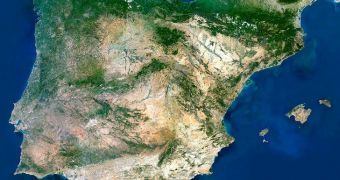A recent paper in the journal Renewable Energy shows that, if exploited properly, the underbelly of the Iberian Peninsula has the potential to take the business of generating energy from geothermal power to a whole new level.
What the specialists behind this paper mean to say is that, according to evidence at hand, the subsoil of the Iberian Peninsula could cough out as much as 700 gigawatts of clean power. This would help curb emissions and ensure energy security.
To put things into perspective, it must be said that this 700 gigawatts capacity exceeds Spain's current overall energy generating capacity several times over, Phys Org tells us.
As researcher César Chamorro puts it, “The 700 GW of electricity indicated in the study represent approximately five times the current electrical power installed in Spain, if we add together fossil fuels, nuclear and renewable power.”
The part of the Iberian Peninsula scientists say we should at least try and exploit sits at a depth of about 3 to 10 kilometers (approximately 1.86 to 6.21 miles) below the surface. According to Phys Org, temperatures here are about 150 degrees Celsius (302 degrees Fahrenheit).
The only problem is that, in order to tap into this energy potential, enhanced geothermal systems need be put to work. As detailed in the journal Renewable Energy, such systems harvest geothermal power with the help of liquids that are injected in the underground and absorb heat.
“The operation of an enhanced geothermal system uses the injection of a fluid (water or carbon dioxide) to extract thermal energy from the rock located a few thousand metres below the surface, and whose permeability has been improved or stimulated previously with fracturing processes.”
“Afterwards, the heated fluid is taken upwards to the geothermal station, where it produces electricity, generally via a binary cycle (exchanging heat between the water and an organic liquid), and it is re-injected into the site in a closed cycle,” says César Chamorro.
The problem is that, for the time being, enhanced geothermal systems are not exactly common sight. On the contrary, the only one currently connected to the grid is Soultz-sous-Forêts in France. However, experimental ones are up and running in the United States, Australia, and Japan.
Specialist César Chamorro claims that, should efforts be made to boost the popularity of enhanced geothermal systems like the one that is now operational in France, significant progress could be made in terms of meeting global energy demands while curbing emissions at the same time.
“In the case of Spain, EGS systems could significantly contribute to the national energy mix, reducing energy dependency on other countries and cutting greenhouse gases,” César Chamorro and fellow researchers argue.

 14 DAY TRIAL //
14 DAY TRIAL //